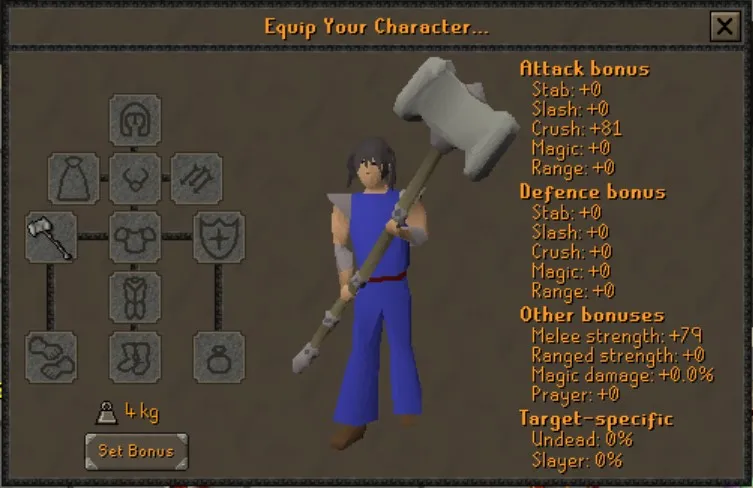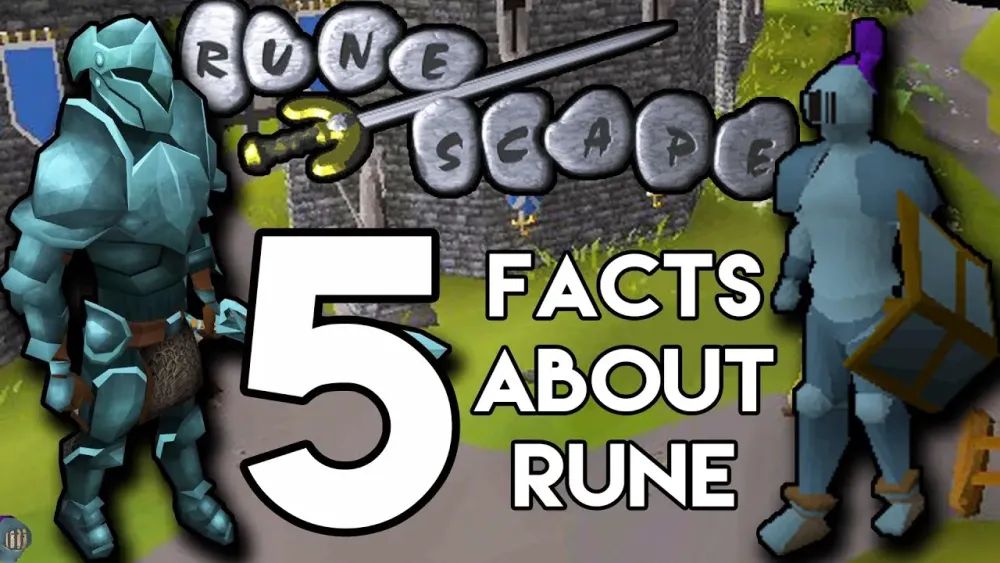Your cart is empty
Granite vs Rune Armor in OSRS – Which Is Better for You?

In Old School RuneScape (OSRS), choosing the right armor can make or break your gameplay, whether you’re slaying monsters, tackling quests, or diving into PvP. Two popular options for mid-level players are granite armor and rune armor. Both are accessible around level 50 Defence, but they cater to different playstyles and priorities. This guide dives deep into the granite vs rune armor debate, comparing stats, costs, aesthetics, and practical uses to help you decide which suits your needs best.
Before we compare the two, let’s get a clear picture of what granite and rune armor offer. Both sets are iconic in OSRS, but they come with distinct characteristics that influence their effectiveness in various scenarios.
What Is Rune Armor?
Rune armor is the go-to choice for free-to-play (F2P) players and early members. Requiring 40 Defence to wear (50 for the platebody, which needs Dragon Slayer I completion), it’s crafted via Smithing or dropped by monsters. Rune armor is lightweight, affordable, and versatile, making it a staple for players transitioning from lower-tier gear like adamant.
What Is Granite Armor?
Granite armor, exclusive to members, requires 50 Defence and 50 Strength to equip. It’s heavier, tankier, and obtained through specific means, like monster drops or Barbarian Assault for the granite body. Granite gear is known for its superior defensive stats, particularly against ranged attacks, but its weight can be a drawback.
Stat Comparison – Granite vs Rune Armor

To understand which armor is better, let’s break down their stats. The differences in defensive bonuses, weight, and requirements play a big role in their practical use.
Defensive Bonuses
Granite armor generally outshines rune armor in defensive stats, especially for the body slot. Here’s a detailed look at the granite body vs rune platebody:
| Armor | Stab Defence | Slash Defence | Crush Defence | Ranged Defence | Weight |
|---|---|---|---|---|---|
| Granite Body | +87 | +84 | +92 | +109 | 22 kg |
| Rune Platebody | +82 | +80 | +80 | +80 | 9.98 kg |
The granite body offers better protection across the board, with a massive +29 ranged defence advantage. However, other granite pieces like the legs and helm don’t always surpass rune counterparts. For example, granite legs have lower melee defence than rune platelegs, though they excel in ranged defence (+49 vs +26).
Weight and Mobility
Weight is a critical factor in OSRS, affecting run energy depletion. Granite armor is notoriously heavy:
- Granite body: 22 kg
- Granite legs: 15 kg
- Granite shield: 6 kg
In contrast, rune armor is much lighter:
- Rune platebody: 9.98 kg
- Rune platelegs: 9 kg
- Rune kiteshield: 5.44 kg
If you’re traveling long distances or engaging in activities requiring mobility (e.g., quests or Slayer tasks), rune armor’s lighter weight makes it more practical. Granite’s heft can drain run energy quickly, which is a dealbreaker for some players.
Strength Requirements
Granite armor’s 50 Strength requirement can be a hurdle for players focusing purely on Defence or Attack. Rune armor has no Strength prerequisite, making it more accessible for builds like pures or low-Strength accounts. If your Strength is below 50, rune is your only option until you train up.
Cost and Acquisition
Budget and availability are huge considerations in OSRS. Let’s explore how granite and rune armor stack up in terms of cost and how you get them.
Rune Armor – Cheap and Accessible
Rune armor is one of the most affordable options for its tier. As of April 2025, approximate Grand Exchange prices are:
- Rune platebody: ~38k coins
- Rune platelegs: ~38k coins
- Rune full helm: ~20k coins
- Rune kiteshield: ~32k coins
You can buy rune armor from the Grand Exchange, smith it yourself (requires high Smithing levels, e.g., 99 for platebody), or get it as drops from monsters like greater demons. Its low cost and availability make it ideal for F2P players or those saving for upgrades like dragon armor.
Granite Armor – Pricier and Exclusive
Granite armor is more expensive and harder to obtain, as it’s members-only and tied to specific content:
- Granite body: ~150k coins (purchased from Barbarian Assault for 95k coins after killing the Penance Queen)
- Granite legs: ~350k coins (dropped by Skeletal Wyverns)
- Granite helm: ~50k coins (dropped by terror dogs)
- Granite shield: ~35k coins (dropped by trolls)
Granite’s higher cost reflects its better stats, but acquiring pieces like the body requires time investment in Barbarian Assault, which can be a grind. If you’re on a tight budget, rune armor is far easier to grab.
When to Use Granite Armor
Granite armor shines in specific situations where its strengths outweigh its drawbacks. Here are scenarios where it’s the better choice:
Tanking Ranged Attacks
Granite’s exceptional ranged defence makes it ideal for fighting monsters with ranged attacks, like Skeletal Wyverns or certain Slayer tasks. The granite body and shield can significantly reduce damage taken compared to rune armor.
Low-Level Tanking
For players who prioritize defence over offence, granite armor is a solid choice before accessing high-end gear like Bandos or Barrows. It’s especially useful for mid-level PvM, where you need to absorb hits while training combat skills.
Barbarian Assault Enthusiasts
If you’re grinding Barbarian Assault, the granite body is a natural pickup. Its defensive bonuses complement the minigame’s demands, and you’ll already be investing time there to unlock it.
Pro Tip: Pair granite armor with a Fighter Hat from Barbarian Assault for a slight melee boost if you’re not using a helm slot for other gear.
When to Use Rune Armor
Rune armor remains a favorite for its versatility and ease of use. Here’s when it’s the smarter pick:
Mobility and General Use
Rune armor’s lighter weight makes it better for quests, Slayer tasks, or any activity involving lots of running. For example, during Monkey Madness or Desert Treasure, granite’s weight can slow you down, while rune keeps you nimble.
Free-to-Play Players
F2P players have no access to granite, so rune is the best armor available. It’s perfect for PvP in the Wilderness, training at places like the Stronghold of Security, or tackling bosses like Obor and Bryophyta.
Budget Builds and Pures
If you’re saving for dragon armor, Barrows, or other upgrades, rune armor is a cost-effective stopgap. Pures with low Strength can also use rune without worrying about granite’s 50 Strength requirement.
Pro Tip: Consider gilded or god-trimmed rune armor for a stylish edge in PvP or social settings, though these variants don’t improve stats.
Aesthetics and Community Perception
In OSRS, looks matter as much as stats for some players. Let’s talk about how granite and rune armor fare in the fashion department and what the community thinks.
Granite Armor’s Look
Granite armor has a rugged, stone-like appearance that screams “tanky.” However, it’s often mocked as “noob gear” due to its bulky design and association with mid-level players trying to look tough. The granite body’s grey, rocky texture doesn’t blend well with many capes or weapons, limiting its fashion potential.
Rune Armor’s Classic Appeal
Rune armor, with its sleek blue and silver design, is a timeless classic. It’s less likely to draw snickers and pairs well with a variety of weapons and accessories. Variants like gold-trimmed or Saradomin rune armor add flair for players who want to stand out without breaking the bank.
Community Verdict
Reddit threads and forums like the 2007scape subreddit often lean toward rune for its lighter weight and cleaner look, with comments like, “Granite is tanky but looks awful”. Granite gets praise for specific uses (e.g., ranged defence), but rune’s versatility wins more hearts. Ultimately, if FashionScape is your thing, rune has the edge.
Final Verdict – Which Should You Choose?
So, granite vs rune armor—which is better? It depends on your goals:
- Choose granite armor if: You need high ranged defence, are tanking in PvM, or are grinding Barbarian Assault. Its superior stats make it worth the weight for defensive playstyles.
- Choose rune armor if: You’re F2P, on a budget, need mobility, or prefer a classic look. It’s versatile and practical for most mid-level activities.
For most players, rune armor is the better all-rounder due to its accessibility and lighter weight. However, if you’re facing ranged-heavy foes or want a tankier setup, granite’s defensive edge is undeniable. Consider mixing pieces—e.g., granite body with rune legs—for a balanced approach.
Whichever you pick, both sets are stepping stones to higher-tier gear like dragon, Barrows, or Bandos. Experiment with what fits your playstyle, and don’t be afraid to flex your choice in Gielinor!
